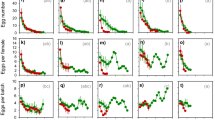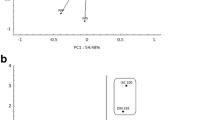Abstract
Rice plant volatiles extracted as steam distillates significantly affected the behavior and biology of the brown planthopper,Nilaparvata lugens (Stål). In a multichoice test, more females settled and fed on tillers of a susceptible rice variety “Taichung Native 1” (TN1), sprayed with its own extract or acetone than on TN1 tillers sprayed with the extract of the resistant variety “ARC6650” or “Ptb33.” In another test,N. lugens females ingested significantly more of a 10% sucrose solution mixed with TN1 steam distillate extract than of plain sucrose solution or that mixed with extracts of resistant varieties. Topical application of the extracts of resistant varieties “Mudgo,” “ASD7,” “Rathu Heenati,” “Babawee,” Ptb33, and ARC6650 caused significantly higher mortality of females than did the TN1 extract. Likewise, significantly more first-instar nymphs died when they were caged on susceptible TN1 plants sprayed with the extracts of resistant varieties than on plants sprayed with TN1 extract. The extract of 60-day-old resistant plants was more toxic than the extract of 30-, 45-, or 100-day-old plants. However, toxicity of the extract from susceptible TN1 remained low at all plant growth stages.
Similar content being viewed by others
References
Abbott, W.S. 1925. A method for computing effectiveness of an insecticide.J. Econ. Entomol. 18:265–267.
Bernays, E.A. 1982. The insect on the plant—a closer look, pp. 3–17,in J.H. Visser and A.K. Minks (eds.) Proc. 5th Int. Symp. Insect-Plant Relationships, Wageningen, 1982. Pudoc, Wageningen, 1982.
Bianchi, G., Luppotto, E., andRusso, S. 1979. Composition of epicuticular wax of rice,Oryza sativa. Experientia 35:1417.
Buvat, R. 1969. Plant Cells: An Introduction to Protoplasm. McGraw-Hill, New York.
Chapman, R.F., andBernays, E.A. 1977. The chemical resistance of plants to insect attack, pp. 603–643,in G.B. Marini-Bettolo (ed.). Study Week on Natural Products and Protection of Plants. Pontifica Academia Scientiarum, Casina F10 IV, Citta Del Vaticano.
Dethier, V.G. 1970. Chemical interactions between plants and insects, pp. 83–102,in E. Sondheimer and J.B. Simeone (eds.). Chemical Ecology, Academic Press, New York.
Duncan, D.B. 1951. A significance test for differences between ranked treatments in an analysis of variance.V. J. Sci. 2:171–189.
Ebeling, W. 1964. The permeability of the insect cuticle, pp. 507–556,in M. Rockstein (ed.). The Physiology of Insecta, Vol. III. Academic Press, New York.
Flück, H. 1963. Intrinsic and extrinsic factors affecting the production of secondary plant products, pp. 167–186,in T. Swain (ed.). Chemical Plant Taxonomy. Academic Press, New York.
Fraenkel, G. 1959. The raison d'etre of secondary plant substances.Science 129:1466–1470.
Fraenkel, G. 1969. Evaluation of our thoughts on secondary plant substances.Entomol. Exp. Appl. 12:473–486.
Goldstein, J.L., andSwain, T. 1963. Changes in ripening fruits. Phytochemistry 2:371–383.
Gunther, E. 1952. The Essential Oils, 2nd ed., Vol. V. Van Nostrand, New York.
Kawabe, S., Fukumorita, T., andChino, M. 1980. Collection of rice phloem sap from stylets of homopterous insects severed by YAG laser.Plant Cell Physiol. 21:1319–1327.
Khush, G.S. 1979. Genetics of breeding for resistance to the brown planthopper, pp. 321–332,in International Rice Research Institute. Brown Planthopper: Threat to Rice Production in Asia. Laguna, Philippines.
Kim, M., Koh H., Obata, T., Fukami, H., andIshii, S. 1976. Isolation and identification oftrans- aconitic acid as the antifeedant in barnyard grass against the brown planthopper,Nilaparvata lugens (Stål) (Homoptera: Delphacidae).Appl. Entomol. Zool. 11:53–57.
McKey, D. 1979. The distribution of secondary compounds within plants, pp. 56–133,in G.A. Rosenthal and D.H. Janzen (eds.). Hervibores—Their Interaction with Secondary Plant Metabolites. Academic Press, New York.
Obata, T., Koh, H., Kim, M., andFukami, H. 1983. Constituents of planthopper attractant in rice plant.Appl. Entomol. Zool. 18:161–169.
Pathak, M.D., Cheng, C.H., andFortuno, M.E. 1969. Resistance toNephotettix impicticeps andNilaparvata lugens in varieties of rice.Nature 223:502–504.
Reese, J.C. 1979. Interaction of allelochemics with nutrients in herbivore food, pp. 309–330,in G.A. Rosenthal and D.H. Janzen (eds.). Herbivores—Their Interaction with Secondary Plant Metabolites. Academic Press, New York.
Robinson, T. 1983. The Organic Constituents of Higher Plants: Their Chemistry and Interrelationships, 5th ed. Cordus Press, North Amherst, Massachusetts.
Saxena, R.C. 1978. Biochemical basis of resistance in crop plants. International Rice Research Institute, Saturday Seminar, March 11, 1978, Los Baños, Laguna, Philippines. 25S pp. (mimeo.)
Saxena, R.C., andPathak, M.D. 1979. Factors governing susceptibility and resistance of certain rice varieties to the brown planthopper, pp. 304–317,in International Rice Research Institute. Brown Planthopper: Threat to Rice Production in Asia. Laguna, Philippines.
Saxena, R.C., andPuma, B.C. 1979. Bases of plant resistance—rice brown planthopper. Paper presented at the Annual Research Conference, International Centre of Insect Physiology and Ecology, Nairobi, Kenya, June 3-13, 1979 (abstract).
Shigematsu, V., Murofushi, N., Ito, K., Kaneda, C., Kawabe, S., andTakahashi, N. 1982. Sterols and asparagine in the rice plant, endogenous factors related to resistance against the brown planthopper,Nilaparvata lugens.Agric. Biol. Chem. 46:2877–2896.
Sogawa, K., andPathak, M.D. 1970. Mechanisms of brown planthopper resistance in Mudgo variety of rice (Hemiptera: Delphacidae).Appl. Entomol. Zool. 5:145–158.
Whittaker, R.H. 1970. The biochemical ecology of higher plants, pp. 43–70,in E. Sondheimer and J.B. Simeone (eds.). Chemical Ecology. Academic Press, New York.
Whittaker, R.H., andFeeney, P.P. 1971. Allelochemics: Chemical interactions between species.Science 171:757–770.
Yoshihara, T., Sogawa, K., Pathak, M.D., Juliano, B.O., andSakamura, S. 1979. Soluble silicic acid as a sucking inhibitory substance in rice against the brown planthopper (Delphacidae: Homoptera).Entomol. Exp. Appl. 26:314–322.
Yoshihara, T., Sogawa, K., Pathak, M.D., Juliano, B.O., andSakamura, S. 1980. Oxalic acid as a sucking inhibitor of the brown planthopper in rice (Delphacidae: Homoptera).Entomol. Exp. Appl. 27:149–155.
Author information
Authors and Affiliations
Additional information
Principal Research Scientist (ICIPE), based at International Rice Research Institute (IRRI), P.O. Box 933, Manila, Philippines.
Rights and permissions
About this article
Cite this article
Saxena, R.C., Okech, S.H. Role of plant volatiles in resistance of selected rice varieties to brown planthopper,Nilaparvata lugens (Stål) (Homoptera: Delphacidae). J Chem Ecol 11, 1601–1616 (1985). https://doi.org/10.1007/BF01012115
Received:
Accepted:
Issue Date:
DOI: https://doi.org/10.1007/BF01012115




